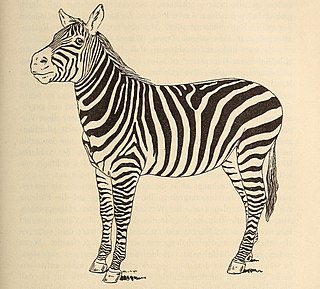Quagga is an extinct subspecies of the plains zebra.
Quagga may also refer to:
- Quagga (software), the unofficial successor to GNU Zebra, a routing software suite
- Quagga catshark, a small shark type
- Quagga mussel, a bivalve species native to Ukraine
Quagga is an extinct subspecies of the plains zebra.
Quagga may also refer to:

Equidae is the taxonomic family of horses and related animals, including the extant horses, asses, and zebras, and many other species known only from fossils. The family evolved around 50 million years ago from a small, multi-toed ungulate into larger, single-toed animals. All extant species are in the genus Equus, which originated in North America. Equidae belongs to the order Perissodactyla, which includes the extant tapirs and rhinoceros, and several extinct families.

The quagga is a subspecies of the plains zebra that was endemic to South Africa until it was hunted to extinction in the late 19th century. It was long thought to be a distinct species, but early genetic studies have supported it being a subspecies of plains zebra. A more recent study suggested that it was the southernmost cline or ecotype of the species.

Zebras are African equines with distinctive black-and-white striped coats. There are three living species: the Grévy's zebra, plains zebra, and the mountain zebra. Zebras share the genus Equus with horses and asses, the three groups being the only living members of the family Equidae. Zebra stripes come in different patterns, unique to each individual. Several theories have been proposed for the function of these stripes, with most evidence supporting them as a deterrent for biting flies. Zebras inhabit eastern and southern Africa and can be found in a variety of habitats such as savannahs, grasslands, woodlands, shrublands, and mountainous areas.

The plains zebra, also known as the common zebra, is the most common and geographically widespread species of zebra. Its range is fragmented, but spans much of southern and eastern Africa south of the Sahara. Six or seven subspecies have been recognised, including the extinct quagga which was thought to be a separate species. More recent research supports variations in zebra populations being clines rather than subspecies.

Breeding back is a form of artificial selection by the deliberate selective breeding of domestic animals, in an attempt to achieve an animal breed with a phenotype that resembles a wild type ancestor, usually one that has gone extinct. Breeding back is not to be confused with dedomestication.

A zebroid is the offspring of any cross between a zebra and any other equine to create a hybrid. In most cases, the sire is a zebra stallion. The offspring of a donkey sire and zebra dam, called a donkra, and the offspring of a horse sire and a zebra dam, called a hebra, do exist, but are rare and are usually sterile. Zebroids have been bred since the 19th century. Charles Darwin noted several zebra hybrids in his works.
Zebra is a routing software package that provides TCP/IP based routing services with routing protocols support such as RIP, OSPF and BGP. Zebra also supports special BGP Route Reflector and Route Server behavior. In addition to traditional IPv4 routing protocols, Zebra also supports IPv6 routing protocols. With SNMP daemon which supports SMUX protocol, Zebra provides routing protocol management information bases.

The quagga mussel is a species of freshwater mussel, an aquatic bivalve mollusk in the family Dreissenidae. It has an average lifespan of 3 to 5 years.

Burchell's zebra is a southern subspecies of the plains zebra. It is named after the British explorer and naturalist William John Burchell. Common names include bontequagga, Damaraland zebra, and Zululand zebra. Burchell's zebra is the only subspecies of zebra which may be legally farmed for human consumption.
Selous is the Anglicised form of the Dutch name Slous. It may refer to:

Grant's zebra is the smallest of the seven subspecies of the plains zebra. This subspecies represents the zebra form of the Serengeti-Mara ecosystem and others across central Africa.

The Quagga Project is an attempt by a group in South Africa to use selective breeding to achieve a breeding lineage of Burchell's zebra which visually resemble the extinct quagga.

Reinhold Eugen Rau was a German natural historian who initiated the Quagga Project in South Africa, which aims to re-breed the extinct quagga, a sub-species of zebra.
Quagga is a network routing software suite providing implementations of Open Shortest Path First (OSPF), Routing Information Protocol (RIP), Border Gateway Protocol (BGP) and IS-IS for Unix-like platforms, particularly Linux, Solaris, FreeBSD and NetBSD.

Crawshay's zebra is a subspecies of the plains zebra native to eastern Zambia, east of the Luangwa River, Malawi, southeastern Tanzania, and northern Mozambique south to the Gorongoza District. Crawshay's zebras can be distinguished from other subspecies of plains zebras in that its lower incisors lack an infundibulum. Crawshay's zebra has very narrow stripes compared to other forms of the plains zebra.
Crawshay is a surname. Notable people with the surname include:

Selous' zebra is a subspecies of the plains zebra distributed across southeastern Africa. It is found mostly in Mozambique.

The maneless zebra is a subspecies of the plains zebra spread over the northern parts of eastern Africa. It ranges in northwestern Kenya to the Karamoja district of Uganda. It is also found in eastern South Sudan, east of the White Nile. It is the northernmost subspecies of the plains zebra. The last remaining substantial population is in Kidepo Valley National Park.
Equus capensis, the Giant Cape zebra, is an extinct species of zebra that lived during the Pleistocene of South Africa. E. capensis was first described from the Cape Town region of South Africa in 1909. E. capensis can be estimated to have grown to about 150 cm (59 in) at the withers and 400 kg (880 lb) in body mass.